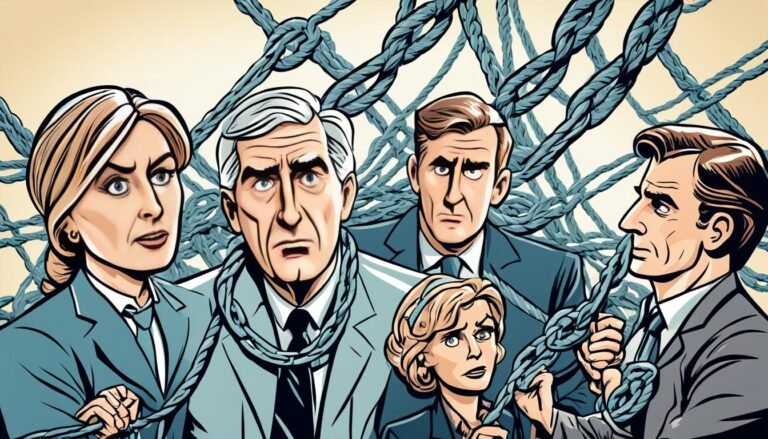Managing Financial Risks in Supply Chains
Welcome to our comprehensive guide on managing financial risks in supply chains. In today’s globalized business landscape, supply chains play a critical role in ensuring the smooth flow of goods and services. However, they are also exposed to various financial risks that can significantly impact a company’s bottom line. Understanding and mitigating these risks is crucial for businesses to maintain a competitive edge in the market.
Key Takeaways
- Effective management of financial risks is vital for the success and sustainability of supply chains.
- Conducting regular risk assessments helps identify and prioritize potential financial risks.
- Supply chain finance plays a pivotal role in mitigating financial risks by providing liquidity and optimizing cash flows.
- Implementing risk mitigation measures such as diversification, insurance, and contingency planning enhances supply chain resilience.
- Ongoing monitoring of supply chain risks using advanced technology and metrics enables proactive risk management.
Understanding Supply Chain Risk Management
Supply chain risk management is a critical aspect of ensuring the smooth operation and financial stability of businesses. In today’s complex and interconnected global economy, supply chains are vulnerable to various risks that can disrupt operations, lead to financial losses, and damage reputations. To effectively manage these risks, organizations must undertake thorough risk assessments in their supply chains.
Risk assessment in supply chains involves identifying, evaluating, and prioritizing potential risks that may occur at different stages of the supply chain. It is a proactive approach that enables businesses to anticipate and prepare for risks, rather than reacting to them after they have already caused harm.
One of the key areas of focus in supply chain risk management is the identification and mitigation of financial risks. Financial risks can arise from factors such as fluctuating exchange rates, payment defaults, supplier insolvencies, and disruptions in cash flow. Failure to address these risks promptly can have detrimental effects on a company’s bottom line and financial stability.
By conducting risk assessments, organizations can gain a comprehensive understanding of the financial risks present in their supply chains. This knowledge empowers them to implement appropriate strategies and measures to minimize the impact of these risks. By proactively managing supply chain risks, businesses can safeguard their financial resources, maintain customer satisfaction, and enhance their overall resilience.
“Supply chain risk management is an essential practice that enables organizations to navigate uncertainties and protect their financial interests. It involves identifying, analyzing, and mitigating risks that can disrupt the flow of goods, information, and funds in the supply chain.”
The Benefits of Supply Chain Risk Management:
- Enhanced operational efficiency by identifying vulnerabilities and developing contingency plans
- Reduced downtime and disruptions through proactive risk mitigation measures
- Improved financial stability and resilience to market fluctuations
- Enhanced relationships with suppliers, customers, and stakeholders through reliable and secure supply chain operations
- Greater ability to adapt to changing market conditions and seize new opportunities
Realizing the Value of Risk Assessment in Supply Chains
By recognizing the potential financial risks in supply chains and the importance of conducting risk assessments, organizations can take proactive measures to safeguard their operations and optimize their financial performance. Effective supply chain risk management strategies enable businesses to navigate uncertainties, identify, and mitigate risks, and create a more resilient and sustainable supply chain ecosystem.
| Risks | Potential Impact | Preventive Measures |
|---|---|---|
| Fluctuating exchange rates | Significant financial losses | Hedging currency risks, considering local sourcing options |
| Payment defaults | Cash flow disruptions, loss of revenue | Performing due diligence on customers, implementing credit risk management practices |
| Supplier insolvencies | Disruptions in the supply chain, delays in production | Diversifying supplier base, monitoring financial health of suppliers |
| Disruptions in cash flow | Financial instability, inability to meet financial obligations | Implementing effective cash flow management practices, building financial reserves |
Mitigating Financial Risks in Supply Chains
Managing financial risks is crucial in ensuring the stability and success of supply chains. By implementing strategies and techniques for financial risk mitigation, businesses can protect themselves from potential disruptions and uncertainties. One effective approach is through supply chain finance, which plays a vital role in managing and reducing financial risks.
Supply chain finance refers to the use of financial instruments, services, and technologies to optimize the management of working capital and liquidity in supply chains. It involves collaboration between buyers, suppliers, and financial institutions to facilitate smooth transactions and mitigate financial risks at various stages of the supply chain.
Benefits of Supply Chain Finance
Supply chain finance offers numerous benefits in terms of financial risk mitigation and overall supply chain efficiency:
- Improved cash flow: By leveraging supply chain finance solutions, businesses can optimize cash flow by accelerating payment cycles and reducing payment delays. This helps mitigate the risk of liquidity constraints and ensures smooth operations.
- Enhanced supplier relationships: Supply chain finance fosters stronger relationships with suppliers by offering them early payment options. This not only improves their cash flow but also provides them with financial stability, reducing the risk of disruptions due to supplier financial distress.
- Risk diversification: Supply chain finance allows businesses to diversify their sources of financing by accessing funding through financial institutions. This reduces dependence on a single source of financing and spreads the financial risk across multiple partners.
- Increased transparency and traceability: Through supply chain finance platforms, businesses can gain better visibility and real-time insights into their financial transactions. This enables proactive risk monitoring and early identification of potential financial risks.
Implementing supply chain finance as a part of overall financial risk mitigation strategy can significantly strengthen a company’s financial resilience and operational efficiency. By embracing innovative financial solutions and collaborating with trusted partners, businesses can effectively manage financial risks and drive sustainable growth.
“Supply chain finance offers businesses the opportunity to mitigate financial risks by optimizing cash flow, strengthening supplier relationships, diversifying sources of financing, and enhancing transparency.”
In the next section, we will discuss the process of conducting supply chain risk analysis and the methods used to identify and assess financial risks in supply chains.
Conducting Supply Chain Risk Analysis
Supply chain risk analysis is an essential process for businesses to identify, assess, and prioritize financial risks in their supply chains. By conducting comprehensive risk assessments, companies can proactively address potential threats and minimize their impact on operations and profitability.
There are several methods and tools available to conduct supply chain risk analysis. One commonly used approach is the use of risk matrices, which involve mapping the likelihood and impact of different risks to determine their overall significance. This method helps in prioritizing risks based on their potential consequences and enables businesses to allocate appropriate resources for mitigation.
“Conducting a thorough supply chain risk analysis allows companies to identify vulnerabilities and develop effective strategies for risk mitigation.”
Additionally, statistical modeling and simulation techniques can provide valuable insights into the potential impact of specific risks on a company’s supply chain. These methods help in quantifying the probability of occurrence and the magnitude of potential losses, enabling businesses to make informed decisions and develop robust risk management strategies.
An Integrated Approach to Risk Assessment
To ensure a comprehensive supply chain risk analysis, it is crucial to adopt an integrated approach that considers both internal and external factors. Internal factors may include operational vulnerabilities, such as inventory management and production capacity, while external factors can include geopolitical events, natural disasters, and economic fluctuations.
By assessing and analyzing these factors, businesses can identify the interdependencies and potential cascading effects within their supply chains. This holistic perspective enables companies to develop targeted risk mitigation measures and contingency plans to address the identified vulnerabilities.
Furthermore, effective risk assessment in supply chains involves collaboration and information sharing with key stakeholders, including suppliers, logistics partners, and customers. By fostering transparent communication, businesses can proactively identify and address potential risks at different stages of the supply chain, enhancing overall supply chain resilience.
| Risk Assessment Methods | Pros | Cons |
|---|---|---|
| Qualitative Risk Assessment | – Easy to understand and implement – Provides a qualitative understanding of risks – Suitable for initial risk identification |
– Subjective nature of assessments – Lack of quantifiable data – Limited in-depth analysis |
| Quantitative Risk Assessment | – Provides a quantitative understanding of risks – Enables informed decision-making – Allows for statistical analysis and modeling |
– Requires extensive data collection – Complex analysis and interpretation – Assumptions may introduce errors |
| Scenario Analysis | – Assesses potential impacts of specific events – Examines plausible future situations – Enables contingency planning |
– Relies on assumptions and projections – Limited to specific scenarios – Difficulty in predicting rare events |
Conducting supply chain risk analysis is a continuous process that requires regular reassessment and adaptation to changing circumstances. By staying proactive and agile in risk management, businesses can ensure the stability and resilience of their supply chains, even in the face of unforeseen challenges.
Developing a Financial Risk Strategy
When it comes to supply chains, proactive management of financial risks is crucial for the long-term success and resilience of businesses. A comprehensive financial risk strategy can help organizations navigate uncertainties and protect their bottom line. In this section, we will explore the key elements and considerations that should be included in the development of a robust financial risk strategy for supply chains.
1. Risk Assessment
Before developing a financial risk strategy, it is essential to conduct a thorough risk assessment. This involves identifying and evaluating potential risks that could impact the financial stability of the supply chain. Consider external factors such as market volatility, geopolitical events, and economic conditions, as well as internal factors like financial dependencies and operational vulnerabilities.
2. Establish Risk Tolerance
Defining the acceptable level of financial risk is a critical step in developing a strategy. Organizations need to evaluate their risk tolerance level based on their financial capabilities, industry dynamics, and unique business objectives. This assessment helps set the foundation for designing risk mitigation measures that align with the organization’s risk appetite.
3. Diversification
One effective way to mitigate financial risks in supply chains is through diversification. By diversifying suppliers, markets, and investments, businesses can reduce their exposure to a single point of failure. This strategy helps create a buffer against disruptions and provides alternative options in times of financial instability.
4. Insurance
Transferring financial risks through appropriate insurance coverage is another vital aspect of a comprehensive financial risk strategy. Adequate insurance policies can safeguard against unexpected events such as natural disasters, accidents, or supplier bankruptcies, providing financial protection and minimizing potential losses.
5. Contingency Planning
Developing contingency plans is essential in preparing for unforeseen financial risks. By creating alternative strategies, organizations can respond swiftly and effectively when disruptions occur. Contingency planning involves identifying potential scenarios, establishing response protocols, and building financial reserves to mitigate the impact of crises.
“A robust financial risk strategy ensures that businesses not only survive but thrive in a constantly evolving economic landscape.”
6. Continuous Monitoring and Evaluation
An effective financial risk strategy is not a one-time effort but an ongoing process. Regular monitoring and evaluation of financial risks in supply chains are crucial to identify emerging threats and assess the effectiveness of mitigation measures. Real-time data analysis and key performance indicators enable organizations to make informed decisions and adjust their strategies accordingly.
7. Collaboration and Transparency
Collaboration and transparency are essential factors in managing financial risks effectively. Establishing open lines of communication and fostering partnerships with suppliers, investors, and stakeholders can facilitate early risk identification, shared risk management efforts, and the development of innovative financial solutions that benefit all parties involved.
8. Technology Adoption
Leveraging technology is instrumental in enhancing financial risk strategies for supply chains. Advanced analytics, blockchain, and artificial intelligence can provide real-time insights, automate risk monitoring processes, and facilitate more accurate forecasting. Embracing digital solutions enables organizations to stay ahead of potential financial risks and make data-driven decisions.
By following these key elements and considerations, organizations can develop a robust financial risk strategy that supports the stability, efficiency, and growth of their supply chains.
Continue reading to Section 6: Implementing Risk Mitigation Measures
Implementing Risk Mitigation Measures
Once potential financial risks have been identified in the supply chain, it is crucial to take proactive measures to minimize their impact. Implementing risk mitigation measures is a key step in ensuring the stability and resilience of your supply chain operations.
One effective technique for financial risk mitigation is diversification. By diversifying your supplier base and spreading your business across multiple suppliers, you can reduce the risk of disruptions caused by a single supplier’s financial instability. This strategy helps to mitigate the potential impact of supply chain disruptions on your business.
Another important measure is insurance. Obtaining suitable insurance coverage for your supply chain can protect your business from financial losses due to various risks, such as natural disasters, transportation accidents, or political instability. Insurance provides a safety net, offering financial support and stability during challenging times.
Contingency planning is also crucial for financial risk mitigation in supply chains. By developing contingency plans for different scenarios, you can better prepare for unexpected events that may disrupt your supply chain. These plans should outline alternative strategies, backup suppliers, and emergency funding options, providing a roadmap to navigate and recover from financial risks.
Risk Mitigation Techniques
| Risk Mitigation Techniques | Description |
|---|---|
| Diversification | Spreading business across multiple suppliers to reduce dependence on a single supplier and minimize the impact of disruptions. |
| Insurance | Obtaining suitable insurance coverage to protect against financial losses caused by supply chain risks. |
| Contingency Planning | Developing plans to address unforeseen events and establish alternative strategies, backup suppliers, and emergency funding options. |
By implementing these risk mitigation measures, businesses can enhance their financial risk management capabilities and foster a more resilient supply chain. Diversification, insurance, and contingency planning are essential tools that provide businesses with the ability to respond effectively to unforeseen circumstances and protect themselves from potential financial risks.
Monitoring Supply Chain Risks
When it comes to supply chains, risk assessment and management are crucial components of maintaining smooth operations. However, identifying and assessing risks is only the first step. Ongoing monitoring is essential to ensure that potential risks are detected and addressed in real-time.
Supply chain risk monitoring involves the continuous surveillance and evaluation of various factors that can impact the financial stability and efficiency of a supply chain. By keeping a close eye on these factors, businesses can proactively address potential risks and take necessary actions to mitigate any adverse effects.
So, what are the tools, metrics, and indicators that aid in supply chain risk monitoring? Let’s take a closer look:
1. Key Performance Indicators (KPIs)
KPIs provide valuable insights into the performance of different aspects of a supply chain, including financial indicators. By tracking financial KPIs such as cash flow, inventory turnover, and days payable outstanding, companies can gain a clear understanding of potential risks and evaluate their financial health.
2. Supplier Performance Metrics
Monitoring the performance of suppliers is vital to ensure that they meet quality, delivery, and compliance standards. By regularly evaluating supplier performance metrics, such as on-time delivery rate, product defect rate, and lead time, businesses can identify potential risks related to supplier reliability and address them promptly.
3. Real-time Data Analysis
Utilizing advanced technologies and analytics tools, businesses can analyze real-time data from various sources, such as IoT sensors, supply chain management systems, and market data. This allows them to detect anomalies or deviations from expected patterns, enabling timely intervention to mitigate potential financial risks.
“Monitoring supply chain risks is not a one-time activity; it requires continuous vigilance and proactive management to stay ahead of potential disruptions.” – [Expert Name]
By leveraging these monitoring tools, businesses can ensure greater visibility and control over their supply chains, enabling them to respond promptly to emerging risks. Additionally, continuous monitoring facilitates the identification of trends and patterns, enabling companies to make informed decisions and implement preventive measures to minimize financial risks.
Ultimately, effective supply chain risk monitoring can help businesses maintain operational resilience, protect their financial interests, and foster trust with customers and stakeholders.
| Benefits of Supply Chain Risk Monitoring | Challenges of Supply Chain Risk Monitoring |
|---|---|
|
|
By actively monitoring supply chain risks, businesses can effectively safeguard their financial stability and ensure efficient operations in the face of evolving market dynamics and unexpected disruptions.
Leveraging Technology for Risk Management
In today’s fast-paced and interconnected business landscape, effective supply chain risk management and a robust financial risk strategy are crucial for the success and sustainability of organizations. With the increasing complexities and uncertainties in global supply chains, businesses need to harness the power of technology to safeguard their operations, optimize performance, and mitigate financial risks.
Supply chain risk management involves identifying, assessing, and mitigating the various risks that can impact the flow of goods, services, and funds throughout the supply chain. By leveraging technology solutions, businesses can enhance their risk management capabilities and make more data-driven decisions. These digital tools provide real-time visibility, predictive analytics, and automation, enabling organizations to proactively identify and respond to potential risks.
One of the key benefits of technology in supply chain risk management is the ability to streamline and automate risk assessment processes. Through advanced algorithms and machine learning capabilities, businesses can analyze vast amounts of data to identify patterns, detect anomalies, and assess the likelihood and impact of potential financial risks.
Furthermore, technology enables organizations to monitor and track supply chain risk indicators, such as demand fluctuations, geopolitical events, labor disruptions, and supplier performance. By having real-time visibility into these factors, businesses can quickly adapt their strategies, identify alternate suppliers, or adjust inventory levels to minimize the financial impact of disruptions.
Digital solutions also facilitate collaboration and communication across various stakeholders in the supply chain. By implementing cloud-based platforms, businesses can centralize data and information, enabling real-time sharing and collaboration between suppliers, manufacturers, distributors, and customers. This seamless flow of information enhances transparency, reduces delays, and improves decision-making, thereby minimizing financial risks.
Moreover, technology enables the implementation of proactive risk mitigation measures. By leveraging artificial intelligence and predictive analytics, businesses can forecast potential risks and simulate scenarios to evaluate the effectiveness of different risk mitigation strategies. This enables organizations to make informed decisions, allocate resources effectively, and develop contingency plans to minimize the financial impact of unforeseen events.
Benefits of leveraging technology for risk management:
- Real-time visibility and transparency across the supply chain.
- Advanced risk assessment and predictive analytics capabilities.
- Proactive monitoring and early detection of potential risks.
- Streamlined collaboration and communication between stakeholders.
- Optimized decision-making and resource allocation.
- Improved resilience and agility in the face of disruptions.
In conclusion, technology plays a pivotal role in enhancing supply chain risk management and developing a robust financial risk strategy. By embracing digital solutions, businesses can gain real-time visibility, automate risk assessment processes, improve collaboration, and proactively mitigate financial risks. As supply chains continue to evolve and become increasingly complex, harnessing the power of technology is essential for organizations to stay ahead, ensure business continuity, and protect their bottom line.
Case Studies on Effective Risk Management
In this section, we will explore real-life case studies that showcase effective supply chain risk management and financial risk strategies. These case studies highlight successful implementations and their outcomes, offering valuable insights into the practical application of risk management strategies.
Case Study 1: Company XYZ
Company XYZ, a global manufacturing company, implemented a robust supply chain risk management framework to mitigate financial risks. By conducting regular risk assessments and identifying vulnerabilities in their supply chain, they were able to proactively address potential disruptions. This strategy helped the company reduce costs and protect its financial stability during unforeseen events, such as natural disasters and market fluctuations.
“Effective supply chain risk management enables companies like XYZ to identify and mitigate financial risks, ensuring business continuity and resilience in volatile market conditions.”
Case Study 2: Retailer ABC
Retailer ABC adopted a comprehensive financial risk strategy to address potential threats in their supply chain. By implementing supply chain finance solutions and collaborating closely with their suppliers, they managed to enhance transparency and efficiency in financial transactions. This strategy allowed them to minimize financial risks associated with payment delays and disruptions, resulting in improved cash flow and stronger relationships with suppliers.
Case Study 3: Logistics Provider DEF
Logistics Provider DEF utilized advanced risk analysis techniques to identify and assess financial risks in their supply chain. By leveraging data analytics and predictive modeling, they were able to forecast potential risks and make informed decisions to mitigate them. This proactive approach empowered DEF to optimize their operations, reduce financial losses, and improve overall supply chain performance.
“These case studies illustrate the importance of adopting effective supply chain risk management and financial risk strategies. By implementing tailored approaches and leveraging data-driven insights, businesses can enhance their resilience, minimize financial risks, and drive sustainable growth.”
By examining these real-world examples, companies can gain inspiration and practical guidance on implementing successful risk management strategies in their own supply chains. These case studies underscore the significance of proactive risk assessment, strategic decision-making, and collaborative partnerships in mitigating financial risks and ensuring long-term success.
Conclusion
Managing Financial Risks in Supply Chains is crucial for the sustainable success and longevity of businesses. Throughout this article, we have explored the importance of supply chain risk management and the strategies that can be implemented to ensure the security and efficiency of financial operations.
By conducting thorough risk assessments, businesses can identify potential financial risks and take proactive measures to mitigate them. The implementation of supply chain finance and diversification techniques can further enhance risk mitigation efforts. Ongoing monitoring using appropriate tools and metrics allows for real-time detection and response to potential financial risks.
Furthermore, leveraging technology has become imperative in today’s dynamic business landscape. Adopting digital solutions enables businesses to streamline supply chain risk management processes and develop effective financial risk strategies.
Ultimately, businesses that prioritize the management of financial risks in their supply chains are better equipped to navigate uncertainty and drive sustainable growth. By employing the strategies discussed in this article, organizations can build resilient supply chains that withstand various challenges, ensuring their financial well-being for years to come.








